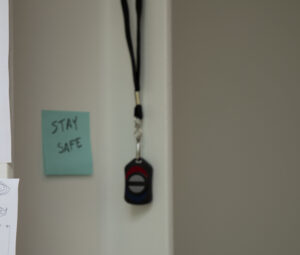
Is a panic button right for your organization? Research reveals that 60-80% of all organizational difficulties stem from strained professional relationships rather than motivation or productivity issues.
Some of these challenges may lead to a crisis situation. This article will outline some strategies for helping staff in volatile scenarios, along with the reasons offices may benefit from a panic button.
Dealing with Conflict on the Job
Countless people have experienced conflict at work. Some have disagreed with their manager on how to best approach an important project. Others have gotten frustrated with colleagues who can’t quite seem to pull their weight.

This is perfectly normal, to some degree, and it can help team members build healthy coping strategies. But certain situations escalate. And in these cases, there isn’t always a clear solution.
Say, for example, an HR representative is letting an employee go. Everything is calm until the person being laid off grows belligerent and angry.
What should the HR rep do? It may seem like it’s too soon to contact the police, but the ex-staff member is yelling. They are approaching their former colleague, pupils dilated, and it looks like the situation could get violent.
Staff shouldn’t have to wait until it’s too late. Yet strategies like active listening, asking clarifying questions, and practicing empathy don’t always work (although they can be very useful in some cases).
For those who are looking to deescalate a volatile situation—for those who may need a coworker to step in—there’s a clear and easy solution.
Investing in a Panic Button
Business managers can absolutely help their staff find ways to seek assistance during a crisis.
A panic button may well be the answer you’ve been waiting for. Hardware and software like TeamAlert can help businesses reduce their risk of violent crime and be proactive in eliminating threats before it’s too late.

panic button
These solutions are versatile. With the literal press of a button, employees can use TeamAlert and similar tech to inform their colleagues they need help by computer or mobile device—via email, text message, phone call, or a combination of the three.
Put simply, a panic button is a subtle yet effective way to request assistance. In addition to being easy to install, they feature seamless software the average person can learn to use in just a few minutes. They’re affordable, well worth the investment in most cases, and quite literally designed to bring peace of mind to employees who may otherwise be concerned.
Some panic buttons are located on employees’ desk phones. Others require third-party installation and only have so many features. While these options are better than nothing, managers should keep in mind the benefits of investing in a solution that’s truly comprehensive.

Again, this is where a TeamAlert panic button comes in. They allow users to:
- Choose how they let their colleagues know they need help.
- Use more than one method if needed (i.e., email and phone).
- Feel safe and reassured for a reasonable price.
- Link to E911 and contact the police automatically, or contact a monitoring service just as an alarm company would.
The features let staff control their preferences no matter where they are. TeamAlert’s mobile app also allows users to raise alerts when they are on the move, even going so far as to display the location where the alert was raised.
During times of workplace crisis, help should be well within reach. Enter the latest generation of the panic button—relatively low-cost, wired and wireless solutions that employees can carry with them. Easily transportable, a key benefit is they’re priced so that everyone on your team can have one.
Building a Safer Work Environment
A panic button isn’t the only way to promote a safer workplace. While these devices are an effective way to deescalate crises, and engage help without drawing too much attention to the situation, there are a number of other strategies that can also increase workplace safety.
Business managers should consider the following to protect their staff:
- Train employees adequately.
Comprehensive onboarding and training can set expectations early. It will let employees know exactly what’s expected of them, offer relevant tools and insights for dealing with conflict in a productive manner, and encourage them to build empathy while improving their communication.
- Facilitate workplace safety meetings.
It’s better to be overprepared than underprepared for a stressful—or potentially volatile—situation. On a quarterly basis, supervisors should consider holding workplace safety meetings to review safety rules and discuss how best to maintain a safe and calm work environment.
- Touch base with employees regularly.
Though meetings are an effective way to start a dialogue at the company level, managers should communicate with staff individually as well. This can help to pinpoint potential issues before they become a problem, making sure team members feel safe and heard as a result.
- Implement proven safety protocols.
Companies can reduce incidents of violence by analyzing their workplace and creating a supportive environment—all while implementing a concrete action plan with proven safety protocols. A panic button can and should be an integral part of the process.
Workplace crisis prevention might not be the most uplifting part of maintaining a healthy company, but it’s vital in protecting your employees. Business leaders must revisit their safety procedures regularly, prioritize communication with each of their team members, and invest in a panic button to mitigate any issues that may arise.
If you are interested in learning more about TeamAlert please contact us today and we would be happy to show you a demo or you can sign up for a free trial and see for yourself what everyone is talking about.
Feel confident that your Staff is protected


